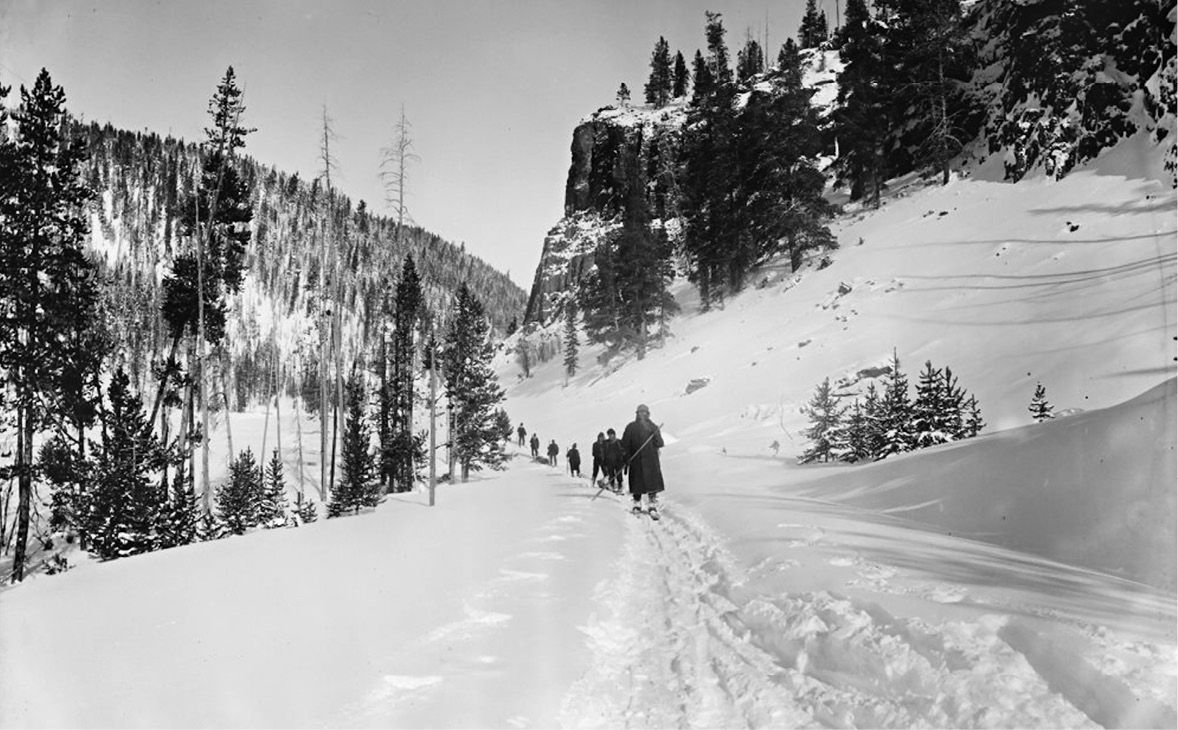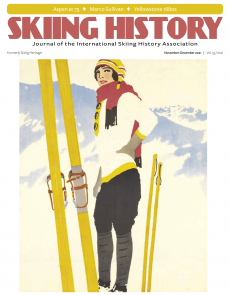SKIING HISTORY
Editor Seth Masia
Managing Editor Greg Ditrinco
Consulting Editor Cindy Hirschfeld
Art Director Edna Baker
Editorial Board
Seth Masia, Chairman
John Allen, Andy Bigford, John Caldwell, Jeremy Davis, Kirby Gilbert, Paul Hooge, Jeff Leich, Ron LeMaster, Bob Soden, Ingrid Wicken
Founding Editors
Morten Lund, Glenn Parkinson
To preserve skiing history and to increase awareness of the sport’s heritage
ISHA Founder
Mason Beekley, 1927–2001
ISHA Board of Directors
Rick Moulton, Chairman
Seth Masia, President
Wini Jones, Vice President
Jeff Blumenfeld, Vice President
John McMurtry, Vice President
Bob Soden (Canada), Treasurer
Einar Sunde, Secretary
Richard Allen, Skip Beitzel, Michael Calderone, Dick Cutler, Ken Hugessen (Canada), David Ingemie, Joe Jay Jalbert, Henri Rivers, Charles Sanders, Christof Thöny (Austria), Ivan Wagner (Switzerland)
Presidential Circle
Christin Cooper, Billy Kidd, Jean-Claude Killy, Bode Miller, Doug Pfeiffer, Penny Pitou, Nancy Greene Raine
Executive Director
Janet White
janet@skiinghistory.org
Membership Services
Laurie Glover
(802) 375-1105
laurie@skiinghistory.org
Corporate Sponsorships
Peter Kirkpatrick
(541) 944-3095
peterk10950@gmail.com
Bimonthly journal and official publication of the International Skiing History Association (ISHA)
Partners: U.S. Ski and Snowboard Hall of Fame | Canadian Ski Museum and Hall of Fame
Alf Engen Ski Museum | North American Snowsports Journalists Association | Swiss Academic Ski Club
Skiing History (USPS No. 16-201, ISSN: 23293659) is published bimonthly by the International Skiing History Association, P.O. Box 1064, Manchester Center, VT 05255.
Periodicals postage paid at Manchester Center, VT and at additional mailing offices. Postmaster: Send address changes to ISHA, P.O. Box 1064, Manchester Center, VT 05255
ISHA is a 501(c)(3) public charity. EIN: 06-1347398
Written permission from the editor is required to reproduce, in any manner, the contents of Skiing History, either in full or in part.
Boiling Springs, Icy Wind, Deepest Snow: 150 Years of Skiing Yellowstone
Skiing predates establishment of the first national park, in 1872.
The unique spectacles of Yellowstone National Park are as engraved on the collective American consciousness as Mount Rushmore, the Grand Canyon and West Coast redwoods. Incredibly, the park’s sights in winter are even more rare and evocative.
Photo above: Skiers from the Haynes Mid-Winter Expedition break trail, circa 1887-1901, in the Obsidian Cliff area, with
several hardy souls pulling fully loaded supply sleds.
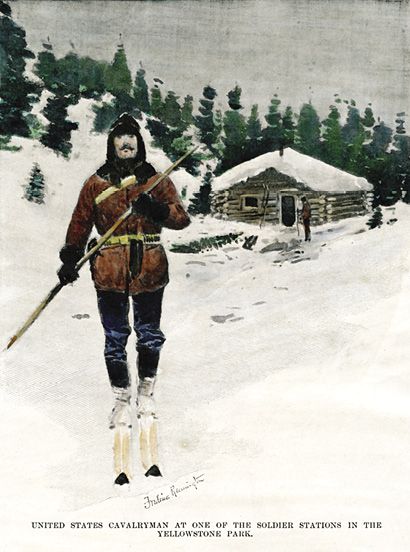
Army officer patrolling Yellowstone. For 32
years, cavalrymen from Fort Custer,
Montana Territory, enforced park regulations.
By 1910, 325 troopers were stationed in the
park. Courtesy New England Ski Museum.
Geyser plumes and steam rise through the brittle-cold air like smoke from hundreds of scattered campfires. Ice-rimed bison look impossibly stoic and noble. Eagles and ravens glide just above rivers warmed by hot springs and floated by trumpeter swans. Elk and moose plow through chest-high drifts, mountain goats the color of the snow roost on sunburned cliffs, and scattered bear paw prints start appearing in the early spring. The rumble of myriad waterfalls are muted when they freeze into stunning ice stalactites, domes and walls. And the visibility stretches across half a dozen mountain ranges and three states.
It’s a big slice of the classic Wild West, literally frozen in time about six months out of every year. In Paul Schullery’s excellent book Yellowstone’s Ski Pioneers, he says that people were probably skiing in the area before it became the world’s first national park in March 1872. The earliest written reference is from a journal by A. Barr Henderson, a miner who started prospecting in the Yellowstone Valley in 1866.
Around Christmas of 1871 Henderson left his camp near present-day Emigrant, Montana, and “went to Bozeman on a pair of 15-foot snow shoes.” At that time his route should have taken him near or through the northern reaches of what would become the park a few months later.
Another likely early skier was Henry Maguire, author of The Coming Empire: A Complete and Reliable Treatise on the Black Hills, Yellowstone and Big Horn Regions (1878). He made numerous winter trips into the park starting in 1873, and while his book makes no mention of skis or skiing, Schullery feels that Maguire would have had to ski, at least sometimes, in order to see what he wrote about.
On an attempt to get to Yellowstone Falls and the geyser basins in December 1873, Maguire was turned back by deep snows and avalanche conditions. Upon reaching Mammoth Hot Springs, he wrote, “I felt amply repaid, however, for making the trip that far. It seemed as though the torrid and frigid zones had met at the spot, and flung together the phenomena peculiar to each. Bright-green ferns, and other water-plants, grew in rank profusion, along the rims of the myriads of perpetually boiling springs, in
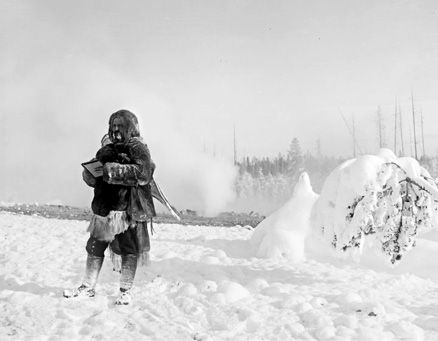
Haynes Mid-Winter Expedition, sketches
near the Norris Geyser Basin. Photo:
FJ Haynes, Montana Historical Society.
the hot breath of which descending snowflakes were converted into water before they reached the earth; while hard by were colossal icicles and trees thickly encased in frost, the surrounding landscape being deeply buried in snow.”
Poachers invade
Unfortunately, most of Yellowstone’s early skiing didn’t center on exploration and sightseeing, but on wholesale wildlife poaching and efforts to prevent it. The harsh winters forced bison, elk and deer into valleys where they could become trapped in deep snow. Hunters on skis had been overwhelming them for years, and that didn’t end when the area became a national park.
“The 1870's was a time of incredible waste and destruction among western wildlife populations, and Yellowstone Park was no exception,” writes Schullery.
General W.E. Strong, who explored Yellowstone on an expedition in 1872, wrote, “In 1870, when Lieutenant Doane first entered the Yellowstone Basin, it was without a doubt unsurpassed on this continent for big game… During the past five years the large game has been slaughtered here by professional hunters by thousands, and for their hides alone.” The meat was left to rot.
Ten years late in coming, an 1883 change in the park regulations prohibited “absolutely” the killing of most wildlife. Yellowstone ski patrols became a big part of the anti-poaching efforts, since the bulk of the damage was done in winter.
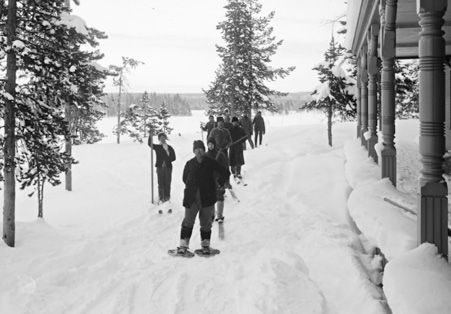
Norris Hotel. FJ Haynes, MHS.
Between the poachers, army ski patrols, various expeditions, the mail delivery system, a growing string of small lodges and ranger stations that were inhabited year-round and increasing numbers of skiing tourists at Mammoth Hot Springs, early Yellowstone was one of the most active ski sites in the country.
Schwatka-Haynes expedition
When a much-ballyhooed 1886–87 winter expedition was launched by the Arctic explorer Lt. Frederick Schwatka and newly-appointed official Yellowstone photographer F. Jay Haynes to catalog the “mysteries” of that season, locals scoffed that it was no new thing to ski around the park in the winter.
“As well talk of ‘exploring’ Central Park, New York, as the National Park. The National Park is a well known country, everything worth seeing is mapped out,” declared seasoned Yellowstone skier Thomas Elwood (“Uncle Billy”) Hofer in a series of stories for Forest and Stream magazine titled “Winter in Wonderland, through the Yellowstone Park on snowshoes.”
No one minimized the risks of a deep dive into winter in country where nighttime temperatures could plunge to -50 Fahrenheit, and the days weren’t always much warmer. Blizzards could strike any time, it was easy to become disoriented and lost, and you had to carry enough food and warm weather gear to survive if that happened. The list of hazards was long, and some seriously hardcore Revenant-style hardships were regularly endured when any untimely mishaps could quickly become life threatening.
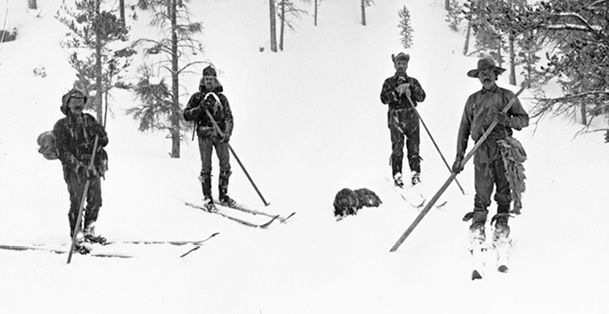
poacher carrying furs. FJ Haynes, MHS
Consider the well-documented story of the biggest poacher bust in the park’s history. Edgar Howell was one of the region’s most notorious and rugged wildlife killers and in 1893 still operated with impunity. But army scout Felix Burgess managed to arrest him on March 12, in the Pelican Valley, for killing some of the last bison in the park. Catching Howell in the act was daring and difficult. But getting him back over the course of two days to Fort Yellowstone at Mammoth Hot Springs was Jack London material. Transporting a dangerous criminal through harsh conditions cost Burgess parts of one foot to frostbite.
As Schullery notes, it would be hard to say when skiing in the park became less about this kind of daunting work and more about recreation. “Indeed it probably always was,” he writes. “Skiing was certainly a popular local activity by the time Fort Yellowstone was built in 1891.” Accounts in 1894 mentioned children skiing at the fort regularly, with skis of all sizes stacked outside many houses, “just as in the park today,” observes Schullery.
In April 1902, President Theodore Roosevelt, who had been instrumental in the park’s creation, went skiing out of Mammoth with nature writer John Burroughs.
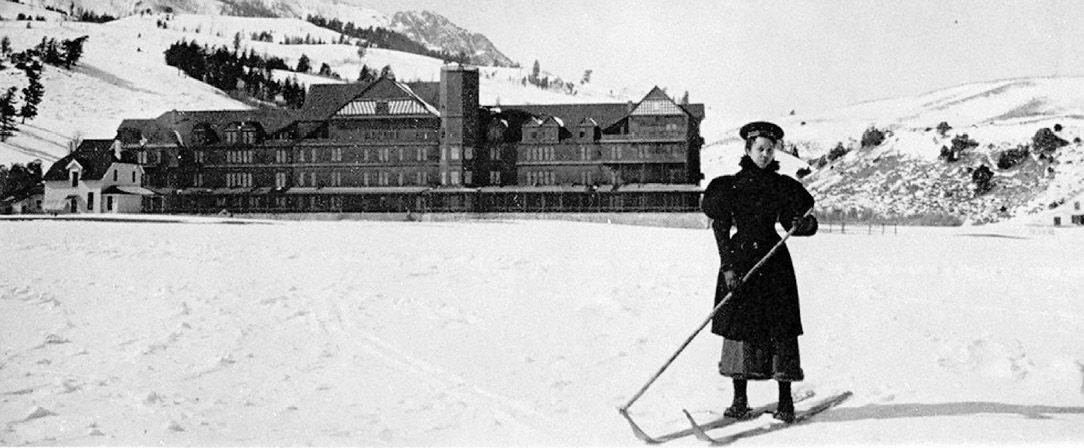
Hot Springs, c. 1896. Photo: Fred Bradley,
University of Montana Mansfield Library.
Alpine skiing, 1941
By 1941, according to Stan Cohen’s comprehensive book Downhill in Montana, a Yellowstone Winter Sports Association was founded “for the purpose of purchasing a ski lift for the use of Yellowstone Park residents and for the promotion of other winter sports activities.” That winter a rope tow was installed on the north side of Mount Washburn. The next season a thousand-foot tow, rising 250 feet, operated east of Mammoth Hot Springs near Undine Falls.
For 50 years the tow furnished regular recreation for park employees and Gardiner and Mammoth residents. Lessons became part of the curriculum at local schools. Then, in 1994, several public controversies over safety issues and possible ski area expansion erupted, and the National Park Service pulled the plug on the ski area. In the meantime, lift-served skiing had sprung up all around the park, in Cody, Jackson Hole, Grand Targhee and Big Sky.
Today cross-country skiing within Yellowstone and Grand Teton is flourishing to the point where conflicts have arisen with snowmobilers and snowcoaches—not to mention concerns about the effect of traffic on the delicate winter ecosystem.
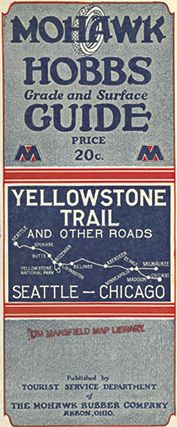
automobile tourists. Mohawk
Rubber Co., University of
Montana Mansfield Library.
Yellowstone under snow poses a harsh enough challenge to flora and fauna without adding increasingly high levels of human interaction to the mix. The average frost-free period is barely more than a month. Annual plants, and even perennials, have a tough time some years, and that directly affects wildlife populations that are already under stress.
Winter can be deadly for many of the park’s species, especially bison, which get scalded by geysers and hot springs and mired in thermal bogs, and sometimes fall through the ice on rivers. One winter, 39 bison broke through on the Yellowstone River and drowned.
Over-winter survival rates among the newborn of most large fauna are often less than 50 percent. Moose calves spend their first two years with their mothers, who protect them from predators and guide them to foraging areas. Deer, elk, moose and bison sometimes team up to take turns breaking trail.
The geothermal areas offer oases of green and blooming plants in midwinter, so temperate that they maintain insect populations. Mosquitoes in January may be annoying, but they’re a small price to pay for making it through another bitter winter.
With all of its brutal challenges for flora, fauna and humans, Yellowstone in winter remains a place of exceptional beauty and wonder that can verge on the spiritual. As all 139 square miles of Yellowstone Lake freeze over, the transformation of water to ice produces “music,” sometimes described as sounding like a great pipe organ or the ringing of telegraph wires. “Sometimes the music plays throughout the night—melodious, vast and harmonious. It stops within a few days when snow begins to accumulate on the ice,” writes Steve Fuller in Snow Country: Autumn, Winter & Spring in Yellowstone. Add to that a full-moon night with a chorus of wolves and coyotes joining in, and the experience can be fully transcendent. 
Frequent contributor Jay Cowan wrote about North American snowfall records in the July–August issue of Skiing History.
Yellowstone: Few Set Tracks, But Lots of Space to Wander
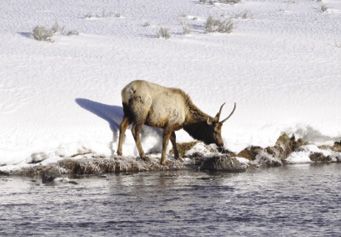
bison calves may be just 50 percent.
Though tracks are only set on a few trails, nearly all unplowed roads and trails in Yellowstone are open to cross-country skiing and snowshoeing. You may find yourself sharing the road with snowmobilers, and there’s always a possibility of wildlife encounters. Some visitors prefer to take a snowcoach from the town of West Yellowstone into Old Faithful or the Upper Geyser Basin and ski on marked trails from there. You can also drive through Grand Teton National Park from the Jackson side, then ski to Yellowstone from there. Mammoth Hot Springs is one of the park’s biggest winter centers. The road is plowed and open all winter to Cooke City, at the park’s far northeastern corner. —J.C.


Table of Contents
WORLD CHAMPIONSHIP ($3,000+)
BerkshireEast/Catamount Mountain Resorts
Gorsuch
Warren and Laurie Miller
Sport Obermeyer
Polartec
CHAMPIONSHIP ($2,000)
Fairbank Group Resorts
Hickory & Tweed
Rossignol
Snowsports Merchandising Corporation
WORLD CUP ($1,000)
Aspen Skiing Company
Bogner of America
Boyne Mountain Resort
Dale of Norway
Darn Tough Vermont
Dynastar/Lange/Look
Gordini USA Inc/Kombi LTD
Head Wintersports
Intuition Sports
Mammoth Mountain
Marker/Völkl USA
National Ski Areas Association
Outdoor Retailer
Ski Area Management
Ski Country Sports
Sports Specialists LTD
Sun Valley Resort
Vintage Ski World
World Cup Supply
GOLD MEDAL ($700)
Larson's Ski & Sports
Race Place/Beast Tuning Tools
The Ski Company (Vicki and Gary Profetta)
Thule
SILVER MEDAL ($500)
Alta Ski Area
Boden Architecture PLLC
Dalbello Sports
Deer Valley
EcoSign Mountain Resort Planners
Elan
Fera International
Holiday Valley Resort
Hotronic USA
Masterfit Enterprises
McWhorter Driscoll LLC
Metropolitan New York Ski Council
Mt. Bachelor
New Jersey Ski & Snowboard Council
Russell Mace Vacation Homes
SchoellerTextil
Scott Sports
Seirus Innovations
SeniorsSkiing.com
Ski Utah
Steamboat Ski & Resort Corp
Sundance Mountain Resort
Swiss Academic Ski Club
Tecnica Group USA
Timberline Lodge and Ski Area
Trapp Family Lodge
Western Winter Sports Reps Association
World Pro Ski Tour
Yellowstone Club

